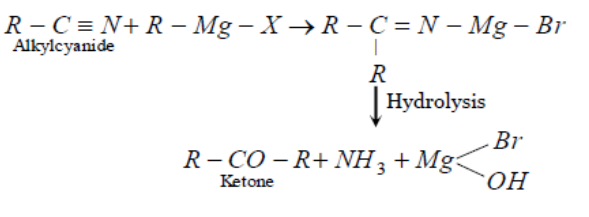
Alkyl cyanides when react with Grignard reagent, the product on hydrolysis found is
A. Aldehyde
B. Ketone
C. Alcohol
D. Acid
Answer
220.2k+ views
Hint: Toluene is a transparent, colourless liquid that, when heated to room temperature, turns into a vapour. Toluene is a naturally occurring component of crude oil and is used in the production of paints, lacquers, explosives (TNT), and glues, in addition to oil refining. Toluene exposure can lead to a variety of symptoms, including irritation of the eyes and nose, exhaustion, headache, dilated pupils, tears, anxiety, muscle fatigue, sleeplessness, and nerve damage.
Complete Step by Step Answer:
Grignard reagent has two parts. In the Grignard reagent the alkyl part acts as a nucleophile that is electron efficient species and wants to donate its electrons. In this reaction in the first step the alkyl part of the Grignard reagent attacks the carbon atom of the alkyl cyanide and the metal part of the Grignard reagent that is magnesium part connects with the nitrogen atom of cyanide.
In the next step water attacks the carbon atom and makes ketone along with ammonia as a side product. The reaction can be given as follows:

Thus we can write that Alkyl cyanides when react with Grignard reagent, the product on hydrolysis found is ketone.
Thus the correct option is B.
Note: Grignard reagent is alkyl or aryl magnesium halide type of compound. In Grignard reagent the alkyl or aryl part acts as a nucleophile and the metal part gets positive charge. Grignard reagents can convert aldehyde and ketone to alcohol. It can also convert acid to alcohol. In these Grignard reagents the metal that is magnesium acts as a hard species.
Complete Step by Step Answer:
Grignard reagent has two parts. In the Grignard reagent the alkyl part acts as a nucleophile that is electron efficient species and wants to donate its electrons. In this reaction in the first step the alkyl part of the Grignard reagent attacks the carbon atom of the alkyl cyanide and the metal part of the Grignard reagent that is magnesium part connects with the nitrogen atom of cyanide.
In the next step water attacks the carbon atom and makes ketone along with ammonia as a side product. The reaction can be given as follows:

Thus we can write that Alkyl cyanides when react with Grignard reagent, the product on hydrolysis found is ketone.
Thus the correct option is B.
Note: Grignard reagent is alkyl or aryl magnesium halide type of compound. In Grignard reagent the alkyl or aryl part acts as a nucleophile and the metal part gets positive charge. Grignard reagents can convert aldehyde and ketone to alcohol. It can also convert acid to alcohol. In these Grignard reagents the metal that is magnesium acts as a hard species.
Recently Updated Pages
Difference Between Alcohol and Phenol: Structure, Tests & Uses

Class 12 Chemistry Mock Test Series for JEE Main – Free Online Practice

Electricity and Magnetism Explained: Key Concepts & Applications

JEE Energetics Important Concepts and Tips for Exam Preparation

JEE Isolation, Preparation and Properties of Non-metals Important Concepts and Tips for Exam Preparation

JEE Main 2021 July 25 Shift 1 Question Paper with Answer Key

Trending doubts
JEE Main 2026: Application Form Open, Exam Dates, Syllabus, Eligibility & Question Papers

Derivation of Equation of Trajectory Explained for Students

Hybridisation in Chemistry – Concept, Types & Applications

Understanding the Angle of Deviation in a Prism

How to Convert a Galvanometer into an Ammeter or Voltmeter

JEE Main Marking Scheme 2026- Paper-Wise Marks Distribution and Negative Marking Details

Other Pages
Solutions Class 12 Chemistry Chapter 1 CBSE Notes - 2025-26

NCERT Solutions For Class 12 Chemistry Chapter 1 Solutions - 2025-26

The D and F Block Elements Class 12 Chemistry Chapter 4 CBSE Notes - 2025-26

NCERT Solutions for Class 12 Chemistry Chapter Chapter 7 Alcohol Phenol and Ether

NCERT Solutions ForClass 12 Chemistry Chapter Chapter 8 Aldehydes Ketones And Carboxylic Acids

JEE Advanced Marks vs Ranks 2025: Understanding Category-wise Qualifying Marks and Previous Year Cut-offs




